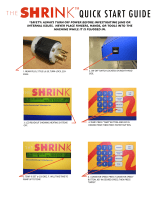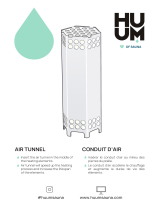
The following drawing shows a typical installation
and is intended to be a guideline. This is not a rigid
specication. Hood dimensions and positioning over
the oven will vary with hood manufacturer.
SMOKE CANDLE TEST
In order to verify the proper function of your ventilation
system, a smoke candle test should be done. If testing
a multiple oven system, this test should be done on
the bottom oven. The conveyor coupling should be
disconnected and the oven temperature must be set
and operating at a minimum of 480°F (249°C).
Test Procedure:
1. Wear heat-resistant gloves to prevent burns.
2. Put the smoke candle in an 8"x8"x2" cake pan.
3. Insert candle through conveyor tunnel or oven
door. (Use Star Smoke Candle 2W-Z5668.)
4. Light the fuse of the smoke candle and immediately
center the pan in the oven cavity on the conveyor
belt (keeping the oven door closed).
5. Observe the smoke pattern coming out of all oven
openings and the collection of this smoke by the
ventilation system.
6. All smoke from the oven must be captured by the
ventilation system.
GAS SUPPLY RATING AND SIZING
Calculations for pipe sizing must take into account
the maximum usage rate of all other appliances in the
kitchen or one or more of the appliances will suffer from
inadequate or dangerous performance. The 1/2" NPT
connection for the oven is generously sized for use
in the control box of the oven. However, unless the
oven installation is within 10 feet of the main building
gas supply, the supply must be larger. For each oven,
a 3/4" NPT exible quick connect hose and full port
gas shut-off valve is recommended as a MINIMUM.
The main pipe supplying each oven branch may need
to be larger depending on the number of appliances
serviced, the number of elbows in the piping, and
the pressure. This should be sized and installed by
a professional familiar with any local codes that may
also affect the installation.
ACCESS CONSIDERATIONS
Locating the gas valve(s), quick connect hose(s) and
electrical outlet(s) at the control box end of the oven
will allow easier access for any service visits. This
improved access should make any necessary service
quicker resulting in less kitchen disruption. It will also
allow easier disconnection of electricity, gas, and
restraints for cleaning around and behind the oven.
ELECTRICAL CONNECTION
Before making any electrical connections to this unit,
check that the power supply is adequate for the voltage,
amperage, and phase requirements stated on the
rating plate. A wiring diagram is included herewith.
When installed, this appliance must be electrically
grounded and its installation must comply with ANSI-
NFPA 70, latest version, manufacturer's installation
instructions, and applicable local municipal building
codes. In Canada, all electrical connections are to be
in accordance with CSA C22.1 - Canadian Electrical
Code Part 1 and/or local codes.
PRESSURE REGULATION AND TESTING
Each oven has been adjusted at the factory to operate
with natural gas. Parts can be ordered for conversion
for use with propane.
Each oven is supplied with a regulator to maintain
the proper gas pressure. The regulator is essential
to the proper operation of the oven and should not be
removed. A pressure reading can be taken at one of
the 1/8" NPT test ports on the bottom or side of the
combination valve. The reading should be taken while
the oven is heating up. The regulator is located on the
bottom of the gas combination valve, just inside the
control box. There is no need to install an additional
regulator where the oven connects to the gas supply
unless the supply exceeds the maximum.
NOTE: The supplied regulator is evaluated for a
maximum gas supply pressure of 14" water column
(34.5 mBar). The recommended maximum gas supply
pressure is 12" water column (29.9 mBar).
Installation must conform with local codes or, in the
absence of local codes, with NFPA54/ANSI Z223.1
- Latest Edition, the Natural Gas Installation Code
CAN/CGA-B149.1 or the Propane Installation Code
CAN/CGA-B149.2 as applicable.
7























